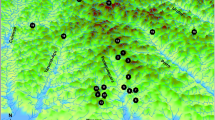Abstract
Larval shell morphology in fossil and present-day gastropods is often used to infer modes of larval development and levels of dispersal. Dispersal ability influences not only genetic population structure, but also is thought to influence a species' geographical range and evolutionary duration. We tested these predictions in Bullia digitalis, a sandy-beach whelk, by examining genetic variability at 33 protein-coding loci in nine samples (N=739) taken in 1984 to 1985 at localities extending over about three-quarters of the geographical range of this species in southern Africa. Females of this species deposit eggs into benthic or brooded capsules in which larvae develop through the trochophore and veliger stages to emerge as crawling juveniles. Scanning electron micrographs confirmed a protoconch morphology typical for gastropods with lecithotrophic larval development. Contrary to expectations, subpopulations of B.␣digitalis had high levels of variability (H=0.102) and lacked a genetically-fragmented structure (=0.013). The lack of a genetically-subdivided population structure would not have been correctly inferred, if this species were known only from well-preserved fossil shells. Indirect estimates of migration between populations based on and the island model of migration, which assumes drift-mutation equilibrium, ranged between 19 and 23 individuals per generation. Either an undescribed mechanism of dispersal facilitates gene flow between populations, or the geographical range of this species has recently expanded to produce the appearance of high levels of gene flow. Gene-frequency distributions showed that relative to four other species of Bullia, populations of B. digitalis were in mutation-drift disequilibrium, with a significant excess of low-frequency alleles that is consistent with a recent rapid expansion from a small population. Also contrary to expectations, this species has a large geographical range (2 400 km) and an apparently long evolutionary history extending 5 to 20 million years, as estimated from an allozyme phylogeny with four other species of Bullia.
Similar content being viewed by others
Author information
Authors and Affiliations
Additional information
Received: 15 January 1997 / Accepted: 28 January 1997
Rights and permissions
About this article
Cite this article
Grant, W., da Silva-Tatley, F. Lack of genetically-subdivided population structure in Bullia digitalis, a southern African marine gastropod with lecithotrophic development. Marine Biology 129, 123–137 (1997). https://doi.org/10.1007/s002270050153
Issue Date:
DOI: https://doi.org/10.1007/s002270050153




